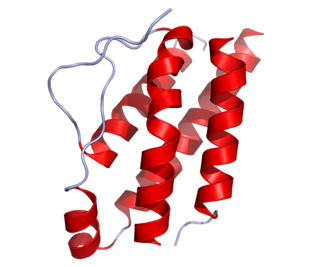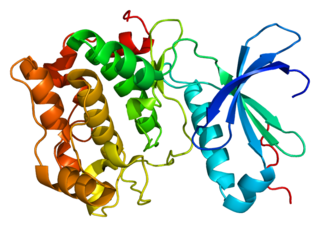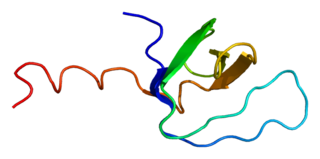Related Research Articles

The T helper cells (Th cells), also known as CD4+ cells or CD4-positive cells, are a type of T cell that play an important role in the adaptive immune system. They aid the activity of other immune cells by releasing cytokines. They are considered essential in B cell antibody class switching, breaking cross-tolerance in dendritic cells, in the activation and growth of cytotoxic T cells, and in maximizing bactericidal activity of phagocytes such as macrophages and neutrophils. CD4+ cells are mature Th cells that express the surface protein CD4. Genetic variation in regulatory elements expressed by CD4+ cells determines susceptibility to a broad class of autoimmune diseases.

Immunosuppressive drugs, also known as immunosuppressive agents, immunosuppressants and antirejection medications, are drugs that inhibit or prevent the activity of the immune system.
Anergy, within the realm of immunology, characterizes the absence of a response from the body's defense mechanisms when confronted with foreign substances. This phenomenon involves the direct induction of peripheral lymphocyte tolerance. When an individual is in a state of anergy, it signifies that their immune system is incapable of mounting a typical response against a specific antigen, typically a self-antigen. The term anergy specifically refers to lymphocytes that exhibit an inability to react to their designated antigen. Notably, anergy constitutes one of the essential processes fostering tolerance within the immune system, alongside clonal deletion and immunoregulation. These processes collectively act to modify the immune response, preventing the inadvertent self-destruction that could result from an overactive immune system.

Superantigens (SAgs) are a class of antigens that result in excessive activation of the immune system. Specifically they cause non-specific activation of T-cells resulting in polyclonal T cell activation and massive cytokine release. Superantigens act by binding to the MHC proteins on antigen-presenting cells (APCs) and to the TCRs on their adjacent helper T-cells, bringing the signaling molecules together, and thus leading to the activation of the T-cells, regardless of the peptide displayed on the MHC molecule. SAgs are produced by some pathogenic viruses and bacteria most likely as a defense mechanism against the immune system. Compared to a normal antigen-induced T-cell response where 0.0001-0.001% of the body's T-cells are activated, these SAgs are capable of activating up to 20% of the body's T-cells. Furthermore, Anti-CD3 and Anti-CD28 antibodies (CD28-SuperMAB) have also shown to be highly potent superantigens.

Interleukin-2 (IL-2) is an interleukin, a type of cytokine signaling molecule in the immune system. It is a 15.5–16 kDa protein that regulates the activities of white blood cells (leukocytes, often lymphocytes) that are responsible for immunity. IL-2 is part of the body's natural response to microbial infection, and in discriminating between foreign ("non-self") and "self". IL-2 mediates its effects by binding to IL-2 receptors, which are expressed by lymphocytes. The major sources of IL-2 are activated CD4+ T cells and activated CD8+ T cells. Put shortly the function of IL-2 is to stimulate the growth of helper, cytotoxic and regulatory T cells.

The T-cell receptor (TCR) is a protein complex found on the surface of T cells, or T lymphocytes, that is responsible for recognizing fragments of antigen as peptides bound to major histocompatibility complex (MHC) molecules. The binding between TCR and antigen peptides is of relatively low affinity and is degenerate: that is, many TCRs recognize the same antigen peptide and many antigen peptides are recognized by the same TCR.
Co-stimulation is a secondary signal which immune cells rely on to activate an immune response in the presence of an antigen-presenting cell. In the case of T cells, two stimuli are required to fully activate their immune response. During the activation of lymphocytes, co-stimulation is often crucial to the development of an effective immune response. Co-stimulation is required in addition to the antigen-specific signal from their antigen receptors.
Interleukin 27 (IL-27) is a member of the IL-12 cytokine family. It is a heterodimeric cytokine that is encoded by two distinct genes, Epstein-Barr virus-induced gene 3 (EBI3) and IL-27p28. IL-27 is expressed by antigen presenting cells and interacts with a specific cell-surface receptor complex known as IL-27 receptor (IL-27R). This receptor consists of two proteins, IL-27Rɑ and gp130. IL-27 induces differentiation of the diverse populations of T cells in the immune system and also upregulates IL-10.
Understanding of the antitumor immunity role of CD4+ T cells has grown substantially since the late 1990s. CD4+ T cells (mature T-helper cells) play an important role in modulating immune responses to pathogens and tumor cells, and are important in orchestrating overall immune responses.
In immunology, peripheral tolerance is the second branch of immunological tolerance, after central tolerance. It takes place in the immune periphery. Its main purpose is to ensure that self-reactive T and B cells which escaped central tolerance do not cause autoimmune disease. Peripheral tolerance prevents immune response to harmless food antigens and allergens, too.

Nuclear factor of activated T-cells, cytoplasmic 2 is a protein that in humans is encoded by the NFATC2 gene.

Nuclear factor of activated T-cells, cytoplasmic 1 is a protein that in humans is encoded by the NFATC1 gene.

Protein kinase C theta (PKC-θ) is an enzyme that in humans is encoded by the PRKCQ gene. PKC-θ, a member of serine/threonine kinases, is mainly expressed in hematopoietic cells with high levels in platelets and T lymphocytes, where plays a role in signal transduction. Different subpopulations of T cells vary in their requirements of PKC-θ, therefore PKC-θ is considered as a potential target for inhibitors in the context of immunotherapy.

T-box transcription factor TBX21, also called T-bet is a protein that in humans is encoded by the TBX21 gene. Though being for long thought of only as a master regulator of type 1 immune response, T-bet has recently been shown to be implicated in development of various immune cell subsets and maintenance of mucosal homeostasis.

Tyrosine-protein kinase Tec is a tyrosine kinase that in humans is encoded by the TEC gene. Tec kinase is expressed in hematopoietic, liver, and kidney cells and plays an important role in T-helper cell processes. Tec kinase is the name-giving member of the Tec kinase family, a family of non-receptor protein-tyrosine kinases.

Nuclear factor of activated T-cells, cytoplasmic 4 is a protein that in humans is encoded by the NFATC4 gene.

The Interleukin-2 receptor alpha chain is a protein involved in the assembly of the high-affinity Interleukin-2 receptor, consisting of alpha (IL2RA), beta (IL2RB) and the common gamma chain (IL2RG). As the name indicates, this receptor interacts with Interleukin-2, a pleiotropic cytokine which plays an important role in immune homeostasis.
T helper 3 cells (Th3) are a subset of T lymphocytes with immunoregulary and immunosuppressive functions, that can be induced by administration of foreign oral antigen. Th3 cells act mainly through the secretion of anti-inflammatory cytokine transforming growth factor beta (TGF-β). Th3 have been described both in mice and human as CD4+FOXP3− regulatory T cells. Th3 cells were first described in research focusing on oral tolerance in the experimental autoimmune encephalitis (EAE) mouse model and later described as CD4+CD25−FOXP3−LAP+ cells, that can be induced in the gut by oral antigen through T cell receptor (TCR) signalling.

The Interleukin-1 family is a group of 11 cytokines that plays a central role in the regulation of immune and inflammatory responses to infections or sterile insults.
Immunometabolism is a branch of biology that studies the interplay between metabolism and immunology in all organisms. In particular, immunometabolism is the study of the molecular and biochemical underpinninngs for i) the metabolic regulation of immune function, and ii) the regulation of metabolism by molecules and cells of the immune system. Further categorization includes i) systemic immunometabolism and ii) cellular immunometabolism. Immunometabolism includes metabolic inflammation:a chronic, systemic, low grade inflammation, orchestrated by metabolic deregulation caused by obesity or aging.
References
- 1 2 3 Pan MG, Xiong Y, Chen F (May 2013). "NFAT gene family in inflammation and cancer". Current Molecular Medicine. 13 (4): 543–54. doi:10.2174/1566524011313040007. PMC 3694398 . PMID 22950383.
- ↑ Crabtree GR, Olson EN (April 2002). "NFAT signaling: choreographing the social lives of cells". Cell. 109 Suppl (2): S67-79. doi: 10.1016/S0092-8674(02)00699-2 . PMID 11983154. S2CID 6542642.
- 1 2 Macián F, López-Rodríguez C, Rao A (April 2001). "Partners in transcription: NFAT and AP-1". Oncogene. 20 (19): 2476–89. doi: 10.1038/sj.onc.1204386 . ISSN 1476-5594. PMID 11402342.
- 1 2 3 4 Park YJ, Yoo SA, Kim M, Kim WU (2020). "The Role of Calcium-Calcineurin-NFAT Signaling Pathway in Health and Autoimmune Diseases". Frontiers in Immunology. 11: 195. doi: 10.3389/fimmu.2020.00195 . ISSN 1664-3224. PMC 7075805 . PMID 32210952.
- 1 2 3 4 5 6 7 Lee JU, Kim LK, Choi JM (2018). "Revisiting the Concept of Targeting NFAT to Control T Cell Immunity and Autoimmune Diseases". Frontiers in Immunology. 9: 2747. doi: 10.3389/fimmu.2018.02747 . ISSN 1664-3224. PMC 6277705 . PMID 30538703.
- 1 2 3 4 5 6 7 8 9 Vaeth M, Feske S (2018). "NFAT control of immune function: New Frontiers for an Abiding Trooper". F1000Research. 7: 260. doi: 10.12688/f1000research.13426.1 . ISSN 2046-1402. PMC 5840618 . PMID 29568499.
- 1 2 Baba Y, Kurosaki T (2016). "Role of Calcium Signaling in B Cell Activation and Biology". B Cell Receptor Signaling. Current Topics in Microbiology and Immunology. Vol. 393. pp. 143–174. doi: 10.1007/82_2015_477 . ISBN 978-3-319-26131-7. PMID 26369772.
- 1 2 Hogan PG (May 2017). "Calcium-NFAT transcriptional signalling in T cell activation and T cell exhaustion". Cell Calcium. 63: 66–69. doi:10.1016/j.ceca.2017.01.014. PMC 5739523 . PMID 28153342.
- ↑ Macian F (June 2005). "NFAT proteins: key regulators of T-cell development and function". Nature Reviews. Immunology. 5 (6): 472–84. doi:10.1038/nri1632. PMID 15928679. S2CID 2460785.
- ↑ Okazaki Y, Furuno M, Kasukawa T, Adachi J, Bono H, Kondo S, et al. (December 2002). "Analysis of the mouse transcriptome based on functional annotation of 60,770 full-length cDNAs". Nature. 420 (6915): 563–73. Bibcode:2002Natur.420..563O. doi: 10.1038/nature01266 . hdl: 10161/11223 . PMID 12466851.
- ↑ Numata K, Kanai A, Saito R, Kondo S, Adachi J, Wilming LG, Hume DA, Hayashizaki Y, Tomita M (June 2003). "Identification of putative noncoding RNAs among the RIKEN mouse full-length cDNA collection". Genome Research. 13 (6B): 1301–6. doi:10.1101/gr.1011603. PMC 403720 . PMID 12819127.
- ↑ Willingham AT, Orth AP, Batalov S, Peters EC, Wen BG, Aza-Blanc P, Hogenesch JB, Schultz PG (September 2005). "A strategy for probing the function of noncoding RNAs finds a repressor of NFAT". Science. 309 (5740): 1570–3. Bibcode:2005Sci...309.1570W. doi:10.1126/science.1115901. PMID 16141075. S2CID 22717118.
- 1 2 3 Rao A, Luo C, Hogan PG (1997). "Transcription factors of the NFAT family: regulation and function". Annual Review of Immunology. 15: 707–47. doi:10.1146/annurev.immunol.15.1.707. ISSN 0732-0582. PMID 9143705.
- 1 2 Sana I, Mantione ME, Angelillo P, Muzio M (2021). "Role of NFAT in Chronic Lymphocytic Leukemia and Other B-Cell Malignancies". Frontiers in Oncology. 11: 651057. doi: 10.3389/fonc.2021.651057 . ISSN 2234-943X. PMC 8047411 . PMID 33869054.
- ↑ Nguyen T, Di Giovanni S (April 2008). "NFAT signaling in neural development and axon growth". International Journal of Developmental Neuroscience. 26 (2): 141–5. doi:10.1016/j.ijdevneu.2007.10.004. PMC 2267928 . PMID 18093786.
- 1 2 Liu Z, Lee J, Krummey S, Lu W, Cai H, Lenardo MJ (October 2011). "The kinase LRRK2 is a regulator of the transcription factor NFAT that modulates the severity of inflammatory bowel disease". Nature Immunology. 12 (11): 1063–70. doi:10.1038/ni.2113. PMC 4140245 . PMID 21983832.
- ↑ Whalen K, Finkel R, Panavelil TA (2014). Pharmacology North American Edition. Lippincott Williams & Wilkins. p. 619. ISBN 978-1-4511-9177-6.
- ↑ Nijkamp FP, Parnham MJ (2005). Principles of Immunopharmacology (2nd rev. and extended ed.). Basel: Birkhèauser Verlag. p. 441. ISBN 978-3-7643-5804-4.